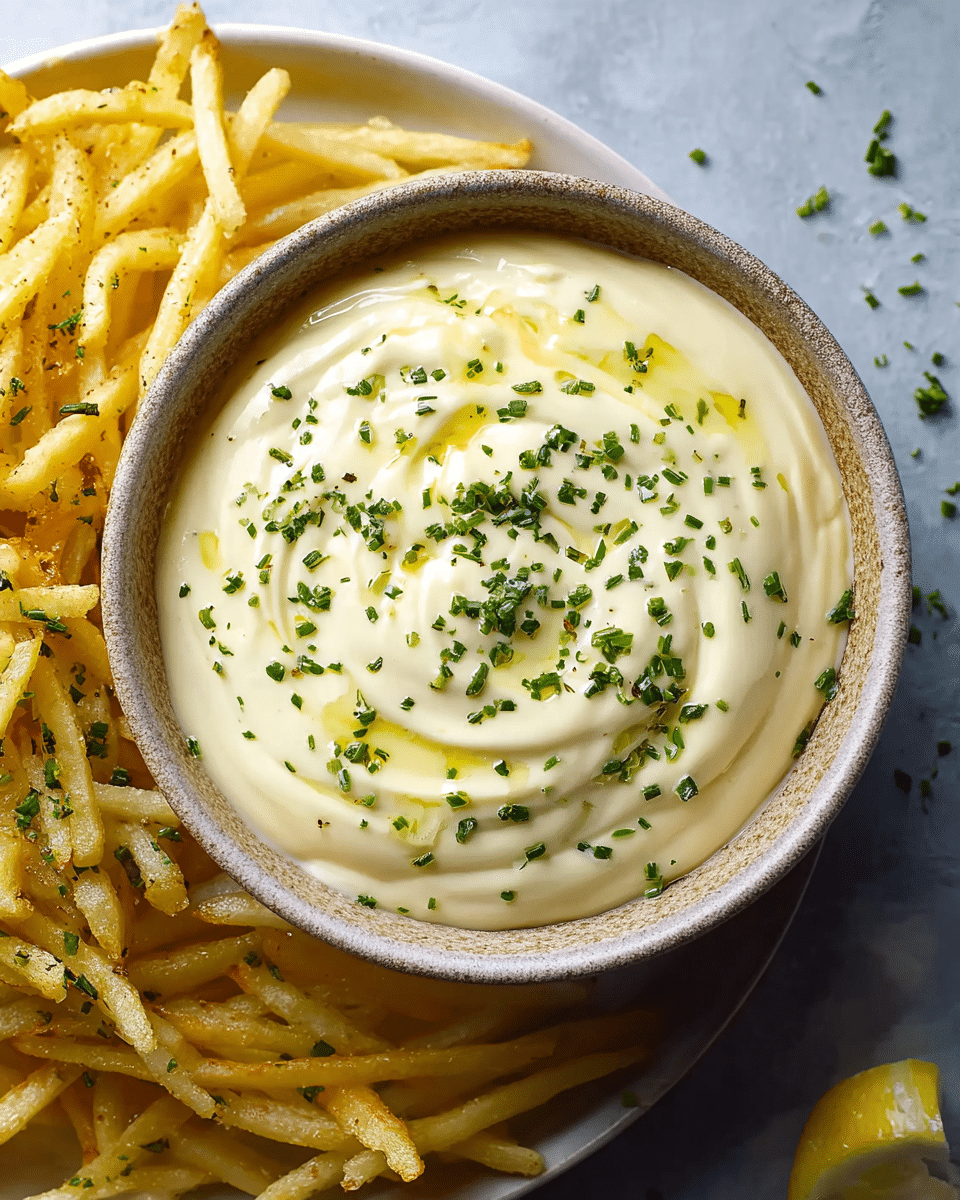This garlic aioli is creamy, rich, and full of savory flavor. It pairs wonderfully with fries, roasted vegetables, or even as a spread for sandwiches and burgers. With a simple combination of fresh ingredients, it’s easy to make and can elevate any dish with its bold, garlicky kick.
Once prepared, this aioli becomes an instant crowd-pleaser. Whether you’re hosting a dinner party or just enjoying a casual meal at home, this garlic aioli is a versatile condiment that can be used in so many ways. Try it as a dip for crispy fries, roasted potatoes, or as a drizzle over grilled vegetables. It’s a must-have in any kitchen!
Full recipe:
Ingredients:
-
1 large egg (room temperature)
-
1 tablespoon Dijon mustard
-
2 teaspoons white wine vinegar
-
2 teaspoons lemon juice
-
1/2 cup olive oil
-
1/2 cup vegetable oil
-
3 garlic cloves, minced
-
Salt and pepper, to taste
Directions:
-
Start by placing the egg, Dijon mustard, white wine vinegar, and lemon juice in a food processor.
-
Pulse for 10 seconds to combine.
-
With the processor running, slowly drizzle in both oils until the mixture emulsifies and thickens.
-
Add the minced garlic and pulse a few more times until well combined.
-
Season with salt and pepper to taste.
-
Transfer the aioli to a bowl and chill in the refrigerator for at least 30 minutes before serving.
Prep Time: 10 minutes | Cooking Time: 0 minutes | Total Time: 10 minutes Kcal: 120 kcal | Servings: 6 servings
The History of Garlic Aioli
Garlic aioli traces its origins to the Mediterranean, particularly in regions such as Spain and Provence, France. The word “aioli” comes from the Provençal language, where “ai” means garlic and “oli” means oil. The classic version of aioli consists of garlic, olive oil, and salt, and it has been a traditional sauce in Mediterranean cuisine for centuries. It was originally made by hand, using a mortar and pestle to slowly emulsify the garlic and oil together.
Over time, the recipe has evolved, especially with the advent of modern food processors and blenders, which make the process faster and easier. While traditional aioli was strictly garlic and olive oil, many variations now include eggs, lemon juice, mustard, or other seasonings, turning it into a more mayonnaise-like consistency.
Today, garlic aioli is not only a cornerstone of Mediterranean cuisine but also a popular accompaniment in various food cultures worldwide. It is commonly paired with dishes like grilled meats, roasted vegetables, and seafood, but its uses are far-reaching.
What Makes Garlic Aioli So Special?
The allure of garlic aioli lies in its simplicity and bold flavors. The key to its deliciousness is the balance between the richness of the oil and the sharp, pungent kick of the garlic. The garlic flavor is often mellowed out through the emulsification process, making it smoother and more complex. Unlike regular mayonnaise, which can sometimes taste heavy or overly tangy, garlic aioli offers a creamy yet light texture with a sharpness that balances out its richness.
Another aspect that makes garlic aioli so special is its versatility. It can be used as a dip for fries, served with grilled meats, spread on sandwiches or burgers, or even drizzled over roasted vegetables. The creamy texture complements a wide variety of dishes, adding depth of flavor without overwhelming the other ingredients. Whether used sparingly or generously, garlic aioli always enhances the dish it’s paired with.
Uses of Garlic Aioli
Garlic aioli is a fantastic addition to many dishes. Here are some of the most popular ways to use it:
-
As a Dip: One of the most common uses for garlic aioli is as a dipping sauce. Whether you’re serving crispy fries, roasted potatoes, or fresh vegetables, garlic aioli makes an excellent accompaniment. Its creamy texture and garlicky flavor perfectly complement the crispy or roasted textures of various foods.
-
On Sandwiches and Burgers: Spread garlic aioli on bread or buns for an added layer of flavor. It works well with a variety of sandwiches, from classic BLTs to turkey and avocado creations. It also enhances the taste of burgers, both beef and veggie, providing a creamy and savory contrast to the other ingredients.
-
With Seafood: Garlic aioli pairs beautifully with seafood. Whether it’s shrimp, crab cakes, or grilled fish, a dollop of garlic aioli can elevate the dish by adding richness and depth. It’s a popular choice for dipping fried calamari or even drizzling over grilled seafood platters.
-
As a Salad Dressing: If you prefer a creamy dressing for your salads, garlic aioli can be thinned out with a bit of lemon juice or water and used as a dressing. Its rich flavor is a great way to add complexity to simple greens or more robust salads with roasted vegetables or grilled chicken.
-
On Roasted Vegetables: The creaminess of garlic aioli complements the earthy flavors of roasted vegetables, like Brussels sprouts, cauliflower, or sweet potatoes. The aioli adds richness, while the garlic brings out the natural sweetness of the vegetables.
-
In Wraps or Tacos: Garlic aioli is a great addition to wraps and tacos, especially those filled with grilled meats or vegetables. It brings a smooth and bold flavor to complement the ingredients inside, creating a satisfying bite every time.
Variations of Garlic Aioli
While the classic garlic aioli recipe is simple, there are many ways to put a spin on this beloved sauce. Depending on your preferences or the dish you’re preparing, you can adjust the ingredients to suit your taste. Here are some popular variations:
-
Lemon Garlic Aioli: Adding fresh lemon juice to garlic aioli gives the sauce a bright and zesty flavor. The acidity of the lemon helps balance out the richness of the oil, making it perfect for pairing with seafood or grilled meats.
-
Spicy Garlic Aioli: If you’re a fan of heat, try adding a bit of chili paste, cayenne pepper, or hot sauce to your garlic aioli. This variation adds an extra layer of spice, which works well with fried foods or even as a topping for spicy burgers.
-
Herbed Garlic Aioli: For a more fragrant and aromatic twist, consider incorporating fresh herbs into your garlic aioli. Herbs like parsley, chives, thyme, or tarragon can elevate the flavor and add a fresh, herbal note to the sauce.
-
Smoked Garlic Aioli: For a deeper, smokier flavor, you can substitute raw garlic with roasted or smoked garlic. This variation works particularly well with grilled meats and vegetables, offering a more savory and earthy depth to the aioli.
-
Vegan Garlic Aioli: For those following a plant-based diet, a vegan version of garlic aioli can be made by substituting the egg with aquafaba (the liquid from canned chickpeas) or a plant-based mayonnaise. This version retains the creamy texture while ensuring it’s entirely vegan.
How to Make Garlic Aioli at Home
Making garlic aioli at home is relatively easy, and it only requires a few simple ingredients. By using a food processor or blender, you can emulsify the oil into the garlic and other ingredients, resulting in a smooth and creamy sauce. The key to a perfect aioli lies in the slow addition of oil, which allows the sauce to thicken and emulsify properly.
Fresh garlic is essential for creating the rich and pungent flavor that aioli is known for. Some recipes call for raw garlic, while others recommend roasted garlic to provide a sweeter and milder taste. Regardless of which garlic you use, it’s important to balance it with the right amount of oil, vinegar, and seasoning to avoid overpowering the sauce.
Conclusion: Why Garlic Aioli is a Must-Have in Your Kitchen
Garlic aioli is a must-have sauce in any kitchen due to its versatility, rich flavor, and ease of preparation. From its Mediterranean roots to its widespread popularity around the world, garlic aioli has become a beloved condiment that can enhance countless dishes. Whether you’re using it as a dip, spread, or dressing, its creamy texture and garlicky flavor will elevate your meal to new heights.
The beauty of garlic aioli lies in its simplicity – with just a few ingredients, you can create a sauce that adds complexity and depth to nearly any dish. Experiment with different variations like lemon, spicy, or herbed aioli to create your own personalized versions. The possibilities are endless, and once you make garlic aioli at home, you’ll wonder how you ever lived without it.
Garlic aioli is not just a sauce; it’s a culinary companion that can transform ordinary meals into extraordinary ones. Whether you’re a beginner or a seasoned cook, this classic sauce is a staple you’ll return to time and time again.






